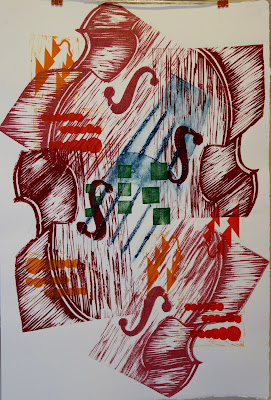My final submission for assignment 5:
In terms of assessment:
- Demonstration of Technical and Visual Skills - materials, techniques, observational skills, visual awareness, design and compositional skillsIn all of these assignments I think my composition skills have developed better than my technical skills. While my technical skills are not bad by any means, I still face some registration problems at times. My chine colle prints had more technical issues, I found this process challenging. My composition skills however have developed with these varied sets of prints. By producing very varied editions I have been able to continue to explore composition and design throughout the assignments which has allowed me to develop my skills in this area.
- Quality of Outcome - content, application of knowledge, presentation of work in a coherent manner, discernment, conceptualisation of thoughts, communication of ideasI have explored some really varied ideas in these assignments and think I have communicated these varied ideas well. My final prints were ambitious, and the concept behind them was abstract but I think clearly communicated. Whether my music and art ideas could have been presented more subtly, or more abstractly is an idea I would like to come back to in the future, and whether this may improve presentation is something I am unsure of at the moment. In projects 13 and 14 the prints did not have such a strong conceptual background but I was trying communicate different moods with the variations of this print, something I feel I have achieved by the diversity of the outcome.
- Demonstration of Creativity - imagination, experimentation, invention, development of a personal voice
This I hope is a strong area of my work. previously I had been more cautious in my choice of subject, I have been much more ambitious and experimental this time and I think this has lead me to develop the beginnings of a personal voice. Thinking big from the outset in project 15 certainly stimulated much more ideas, and now I have finally managed to achieve a better sketch book habit I have been able to capture and explore these in interesting and creative ways in a big range of media. Being more experimental with media in my sketch book definitely helped me develop more ideas and be more creative in these assignments. My water mono prints in project 13 was a really good open starting point for this block, I was able to explore so many variations which continued to develop into my chine colle prints in project 14. - Context - reflection, research, critical thinking (learning log)
I have kept an honest and thorough learning log. I am limited in my access to galleries but those I did visit prompted much further research and greatly informed my artwork. I have learnt a great deal about how artist's communicate through this research which I hope comes through in my log but also in my artwork. Due to my location I have been reliant on web sources for much of this research but have analyzed it critically, carefully assessing sources for reliability.






































